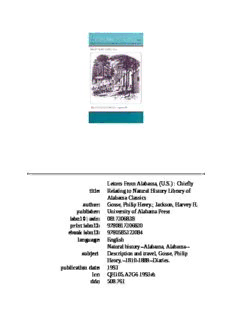
Letters from Alabama, (U.S.): chiefly relating to natural history PDF
Preview Letters from Alabama, (U.S.): chiefly relating to natural history
Letters From Alabama, (U.S.) : Chiefly title: Relating to Natural History Library of Alabama Classics author: Gosse, Philip Henry.; Jackson, Harvey H. publisher: University of Alabama Press isbn10 | asin: 0817306838 print isbn13: 9780817306830 ebook isbn13: 9780585323084 language: English Natural history--Alabama, Alabama-- subject Description and travel, Gosse, Philip Henry,--1810-1888--Diaries. publication date: 1993 lcc: QH105.A2G6 1993eb ddc: 508.761 Natural history--Alabama, Alabama-- subject: Description and travel, Gosse, Philip Henry,--1810-1888--Diaries. Page [1] Letters From Alabama Page [2] The Library of Alabama Classics, reprint editions of works important to the history, literature, and culture of Alabama, is dedicated to the memory of Rucker Agee whose pioneering work in the fields of Alabama history and historical geography continues to be the standard of scholarly achievement. Page [3] Letters From Alabama, (U.S.) Chiefly Relating to Natural History Philip Henry Gosse, F.R.S. An Annotated Edition With an Introduction by HARVEY H. JACKSON III Page [4] Introduction copyright © 1993 The University of Alabama Press Annotations copyright © 1983 Virginia Van der Veer Hamilton All rights reserved Manufactured in the United States of America The paper on which this book is printed meets the minimum requirements of American National Standard for Information Science- Permanence of Paper for Printed Library Materials, ANSI Z39.48- 1984. Library of Congress Cataloging-in-Publication Data Gosse, Philip Henry, 18101888. Letters from Alabama, (U.S.): chiefly relating to natural history/Philip Henry Gosse; with an introduction by Harvey H. Jackson IIIAnnotated ed. p. cm.(The Library of Alabama classics) Originally published: London: Morgan and Chase, 1859. With new introd. Includes bibliographical references. ISBN 0-8173-0683-8 (alk. paper) 1. Natural historyAlabama. 2. Alabama Description and travel. 3. Gosse, Philip Henry, 18101888Diaries. I. Title. II. Series. QH105.A2G6 1993 508.761dc20 92-27936 British Library Cataloguing-in-Publication Data available Page [5] CONTENTS Introduction [7] by Harvey H. Jackson III Facsimile of Title Page iii Preface v Facsimile of Contents vii Letters from Alabama 1 Notes [307] Page [7] INTRODUCTION Harvey H. Jackson III Late on a May afternoon in 1838, English naturalist Philip Henry Gosse landed in Mobile. He found accommodations and the next morning rose "with the first opening of sunlight [and] . . . hasten[ed] into the dense forests which closely environ[ed] the town." Years later he recalled his wonder and delight at what he found. "Everything here was new," he wrote. ''Scarcely a tree occurred that I was familiar with, and few I can now recollect sufficiently to identify." Alabama was a naturalist's dream come true. 1 Gosse arrived in Mobile with a letter of introduction from a friend in Philadelphia addressed to a gentleman who lived upriver at Claiborne. Having heard that educated people were in demand in Alabama, and having few prospects where he was, Gosse took a chance and came south. Though only twenty-eight at the time, he had already seen a lot Page [8] of the world. At the age of seventeen he left his home in England and indentured himself as a clerk in a Newfoundland seal fishery. Six years at that post were followed by a period on a cooperative farm in lower Canada, and when that venture failed he headed farther south, first to Pennsylvania and then to Alabama. 2 Although his formal schooling was limited, Gosse read widely, observed closely, and by the time he reached Mobile his interest in nature and his artistic skill had shaped him into a promising scientist. This background made him appreciate the newness of a scene more than most travelers, for where others saw forests and fields he saw trees, birds, insects, and other animalsincluding man. Moreover, his powers of analysis and his attention to detail enabled him to record what he saw with clarity and insight. These talents would serve him well in Alabama.3 With introduction in hand Gosse booked passage on "one of the fine high-pressure steamers that throng the Mobile wharves" and began his trip to Claiborne. But when the boat arrived at that destination, the Englishman remained on board. This decision was the result of a chance meeting with a fellow passenger, Judge Reuben Saffold. A noted jurist and a member of Alabama's Black Belt planter elite, Saffold was one of "some half-dozen planters of influence" in Dallas County who had agreed "to have their children educated together." It struck Saffold that Gosse was an ideal Page [9] candidate to teach them. The judge offered him the position, along with a "liberal remuneration," and Gosse accepted. He continued upstream, and a short time later the newly hired tutor disembarked at King's Landing, just below Selma. From there Philip Henry Gosse walked the last ten miles to the Saffold plantation near Pleasant Hill. 4 Though Gosse assumed his new office with genuine enthusiasm, the education of "about a dozen 'young ideas'" (as he called his students) was never his principal interest. A naturalist first and foremost, during the eight months he lived in Dallas County he watched, listened, thought, took notes, and made sketchesactivities that led eventually to Letters From Alabama. Written to no one in particular, a common literary device of the period, they were first published nearly two decades later in a magazine, The Home Friend, and in 1859 appeared as a book. By that time the author was an established scholar, a Fellow of the Royal Society, and one of England's most noted scientific illustrators. The book was well received, but apparently it never ranked high among his many accomplishments.5 The audience for whom Gosse intended Letters From Alabama is apparent from the subtitleChiefly Relating to Natural Historyand in it he describes "multitudes of objects to catch the eye and delight the mind of an observant naturalist." Mammals, birds, insects (he especially liked butterflies and moths), and reptiles attracted his at-
Description: